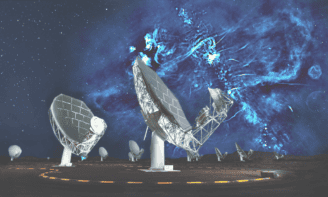Most of the extraterrestrial material on the Earth's surface arrives in the form of micrometeorites - tiny particles less than 1 mm across. Micrometeorites include fragments of asteroids, comets, Mars and our moon, as well as pre-solar and interstellar grains. Most of the particles burn up in the Earth's atmosphere, but a fraction survive to reach the Earth's surface. It is difficult to measure the actual flux of micrometeorites at the surface for many reasons, including weathering of the particles and inefficiencies in collection techniques. Now, however, Susan Taylor and James Lever of the US Army Cold Regions Research and Engineering Laboratory in New Hampshire and Ralph Harvey of Case Western Reserve University in Ohio have been able to measure this flux by collecting micrometeorites from the well which supplies drinking water to the Scott-Amundsen station at the South Pole (S Taylor, J H Lever and R P Harvey 1998 Nature 392 899)
The middle of Antarctica is an ideal place to look for ‘survivors’ of the burn-up because material in the region suffer little, if any, chemical or physical weathering and there is very little contamination. The snow and ice also increase the chances of finding extraterrestrial material. Taylor and colleagues realized that micrometeorites would concentrate at the bottom of the well. Moreover, as ice core samples taken around the base have accurately aged the ice layers, they could also estimate the age of material trapped in the ice.
The team built a remote-controlled robot to vacuum material off the well bottom – which is 20 meters underwater and 100 meters below the ice – without contaminating the water supply. The team estimated that filters attached to the robot collected 99% of the particles with diameters between 50 and 2000 microns – including 0.2 grams of material of exterrestrial origin. This is the largest collection of earth-based micrometeorites ever collected. Comparisons with data from experiments in Greenland and the space-based Long Duration Exposure Facility showed that 10% (±2%) of the particles in the range 50-700 microns reach the Earth’s surface.



